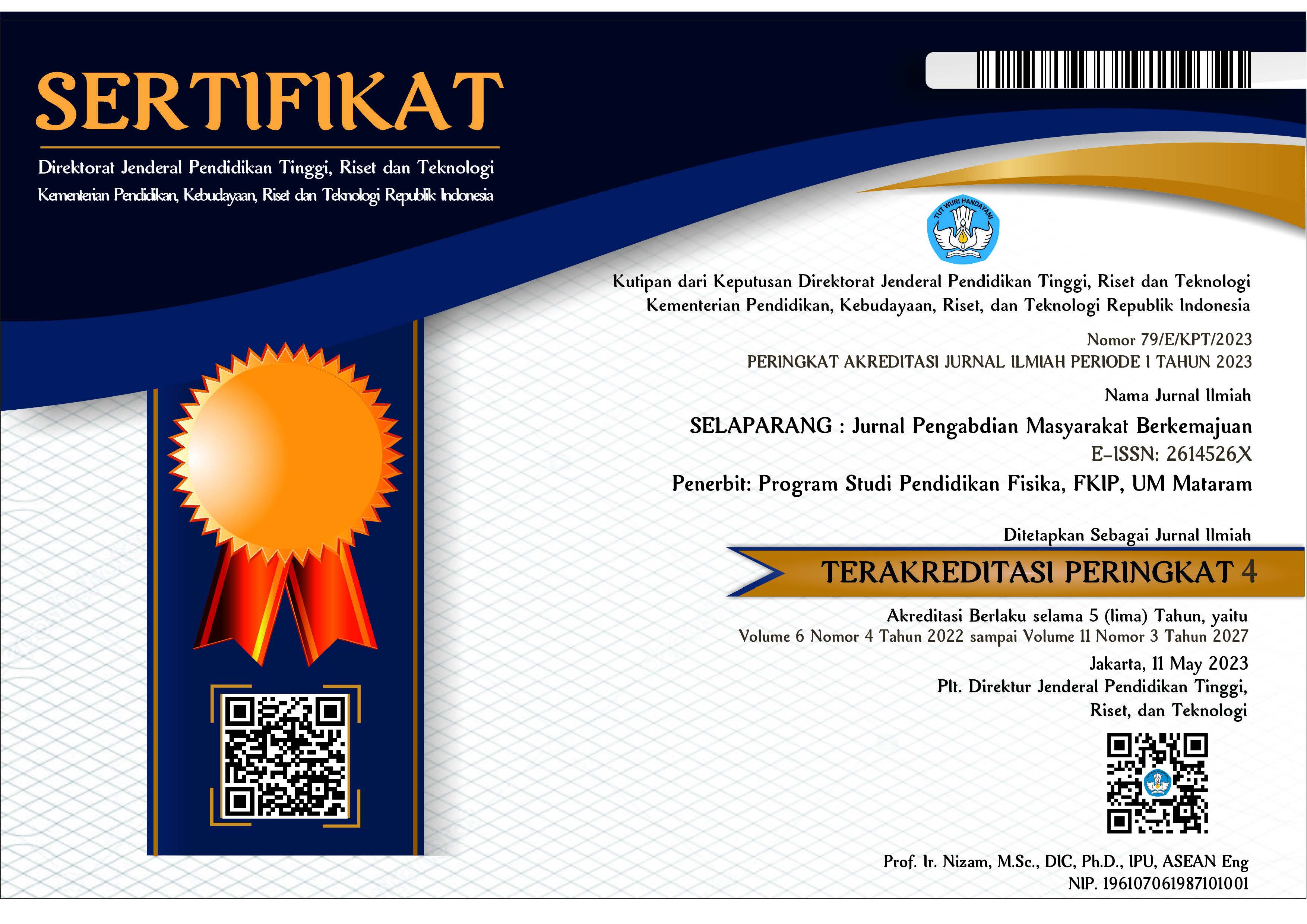HILIRISASI TEKNOLOGI TEPAT GUNA PRODUKSI CENDAWAN ENTOMOPATOGEN DAN Trichoderma DI DESA SUKORAMBI - JEMBER
Abstract
ABSTRAK
Desa Sukorambi di Jember, Jawa Timur, merupakan wilayah yang mayoritas penduduknya menggantungkan hidup dari sektor pertanian. Namun, petani di Desa Sukorambi menghadapi tantangan serius akibat serangan hama yang mengakibatkan penurunan hasil panen yang signifikan. Untuk mengatasi permasalahan ini, diperlukan teknologi pengendalian hayati menggunakan cendawan entomopatogen Metarhizium sp. dan cendawan Trichoderma sp. Sebagai langkah awal, dilakukan sosialisasi dan diskusi dengan mitra dan perangkat Desa Sukorambi untuk memahami permasalahan yang dihadapi dan mengenalkan solusi teknologi yang akan diterapkan. Kemudian, program melibatkan penyusunan materi pelatihan dan pembagian tugas untuk memudahkan pelaksanaan kegiatan. Pelatihan produksi agens hayati berbasis cendawan dilakukan dalam dua pertemuan dengan praktek langsung menggunakan bioreaktor sederhana. Kegiatan pelatihan dan sosialisasi mendapatkan respon positif dan antusias dari masyarakat petani di Desa Sukorambi. Pemahaman, keterampilan, dan motivasi petani mengalami peningkatan yang signifikan setelah pelatihan. Skor pemahaman meningkat dari 3 menjadi 7, keterampilan dari 2,93 menjadi 8, dan motivasi dari 4,2 menjadi 7,4. Diharapkan teknologi pengendalian hayati dengan cendawan entomopatogen dan Trichoderma ini dapat membantu mengatasi masalah serangan hama yang selama ini menghambat pertanian di Desa Sukorambi. Dengan penerapan teknologi yang tepat, diharapkan hasil pertanian akan meningkat secara signifikan dan meningkatkan kesejahteraan petani serta keberlanjutan pertanian di wilayah tersebut.
Kata kunci: bioreaktor; keterampilan; Metarhizium; motivasi; Trichoderma
ABSTRACT
Sukorambi Village, located in Jember, East Java, heavily relies on agriculture for its livelihood. However, farmers face a significant challenge due to pest infestations causing substantial crop yield losses. To address this, the adoption of biologically-based control technology using entomopathogenic fungi Metarhizium sp. and Trichoderma sp. becomes essential. The program began with socialization and discussions involving partners and stakeholders from Sukorambi Village to understand the problems and introduce the proposed solution. Training materials were prepared, and tasks were allocated for seamless execution. Training sessions for bioagents production using fungi were conducted in two phases, incorporating hands-on practice with a user-friendly bioreactor. The initiatives received positive responses from the farming community, with significant improvements in understanding, skills, and motivation. Implementing biologically-based control technology with entomopathogenic fungi and Trichoderma holds promise to effectively address persistent pest challenges, boosting agricultural productivity and improving farmers' socio-economic well-being sustainably.
Keywords: bioreactor; skill; Metarhizium; motivation; Trichoderma
Keywords
Full Text:
PDFReferences
Afif A. S., & Kusmiati A. (2020). Hubungan Tingkat motivasi dengan pendapatan usahatani petani sawi (Brassica juncea) menggunakan benih nonsertifikat di Desa Sukorambi Kecamatan Sukorambi Kabupaten Jember. Jurnal Ekonomi Pertanian dan Agribisnis. 4(3):667-678. https://doi.org/10.21776/ub.jepa.2020.004.03.21.
Alizadeh M., Vasebi Y., & Safaie N. (2020). Microbial antagonists against plant pathogens in Iran: A review. Open Agriculture. 5(1):404-440. https://doi.org/10.1515/opag-2020-0031.
Aw K. M. S., & Hue S. M. (2017). Mode of infection of Metarhizium spp. fungus and their potential as biological control agents. Journal of Fungi. 3(2):30. https://doi.org/10.3390/jof3020030.
Brunner-Mendoza C., Reyes-Montes M. d. R., Moonjely S., Bidochka M. J., & Toriello C. (2019). A review on the genus Metarhizium as an entomopathogenic microbial biocontrol agent with emphasis on its use and utility in Mexico. Biocontrol Science and Technology. 29(1):83-102. https://doi.org/10.1080/09583157.2018.1531111.
Buana B. J. D., & Suwandari A. (2020). Optimalisasi usahatani sayur tumpangsari di Desa Sukorambi Kecamatan Sukorambi Kabupaten Jember. Journal of Social and Agricultural Economics. 13(2):125-144. https://doi.org/10.19184/jsep.v13i2.15124.
Chang X., Yuan Y., Zhang T., Teng H., & Wang D. (2017). Research progress of the biological characteristics and control of the diamondback moth (Plutella xylostella). Acta Agriculturae Shanghai. 33(5):145-150.
Cook D. A., & Artino Jr A. R. (2016). Motivation to learn: an overview of contemporary theories. Medical Education. 50(10):997-1014. https://doi.org/10.1111/medu.13074
Deslauriers L., McCarty L. S., Miller K., Callaghan K., & Kestin G. (2019). Measuring actual learning versus feeling of learning in response to being actively engaged in the classroom. Proceedings of the National Academy of Sciences. 116(39):19251-19257. https://doi.org/10.1073/pnas.1821936116.
Ghazanfar M. U., Raza M., Raza W., & Qamar M. I. (2018). Trichoderma as potential biocontrol agent, its exploitation in agriculture: a review. Plant Protection. 2(3):55-62.
Hoesain M., Pradana A. P., Suharto S., & Alfarisy F. K. (2022). Pendampingan produksi pestisida nabati pada petani hortikultura di Desa Sukorambi Kabupaten Jember. Selaparang: Jurnal Pengabdian Masyarakat Berkemajuan. 6(2):593-597. https://doi.org/10.31764/jpmb.v6i2.7999.
Jaber L. R., & Ownley B. H. (2018). Can we use entomopathogenic fungi as endophytes for dual biological control of insect pests and plant pathogens?. Biological Control. 116:36-45. https://doi.org/ 10.1016/j.biocontrol.2017.01.018.
Mathulwe L. L., Malan A. P., & Stokwe N. F. (2022). Mass production of entomopathogenic fungi, Metarhizium robertsii and Metarhizium pinghaense, for commercial application against insect pests. Journal of Visualized Experiments. (181):e63246. https://dx.doi.org/10.3791/63246.
Mwamburi L. A. (2021). Endophytic fungi, Beauveria bassiana and Metarhizium anisopliae, confer control of the fall armyworm, Spodoptera frugiperda (JE Smith)(Lepidoptera: Noctuidae), in two tomato varieties. Egyptian Journal of Biological Pest Control. 31(1):1-6. https://doi.org/10.1186/s41938-020-00357-3.
Newig J., Challies E., Jager N. W., Kochskaemper E., & Adzersen A. (2018). The environmental performance of participatory and collaborative governance: a framework of causal mechanisms. Policy Studies Journal. 46(2):269-297. https://doi.org/ 10.1111/psj.12209.
Nguyen T. D., Cannata M., & Miller J. (2018). Understanding student behavioral engagement: Importance of student interaction with peers and teachers. The Journal of Educational Research. 111(2):163-174. http://dx.doi.org/10. 1080/00220671.2016.1220359.
Penuel W. R., Riedy R., Barber M. S., Peurach D. J., LeBouef W. A., & Clark T. (2020). Principles of collaborative education research with stakeholders: Toward requirements for a new research and development infrastructure. Review of Educational Research. 90(5):627-674. https://doi.org/10.3102/00346543209381.
Poveda J. (2021). Trichoderma as biocontrol agent against pests: New uses for a mycoparasite. Biological Control. 159:104634. https://doi.org/10.1016/ j.biocontrol.2021.104634.
Rivero‐Borja M., Guzmán‐Franco A. W., Rodríguez‐Leyva E., Santillán‐Ortega C., & Pérez‐Panduro A. (2018). Interaction of Beauveria bassiana and Metarhizium anisopliae with chlorpyrifos ethyl and spinosad in Spodoptera frugiperda larvae. Pest Management Science. 74(9):2047-2052. https://doi.org/10.1002/ps.4884.
Salwan R., Sharma A., Kaur R., Sharma R., & Sharma V. (2022). The riddles of Trichoderma induced plant immunity. Biological Control.32:105037. https://doi.org/10.1016/j.biocontrol.2022.105037.
Sood M., Kapoor D., Kumar V., Sheteiwy M. S., Ramakrishnan M., Landi M., Araniti F., & Sharma A. (2020). Trichoderma: The “secrets” of a multitalented biocontrol agent. Plants. 9(6):762. https://doi.org/10.3390/plants9060762.
Srivastava K., Sharma D., Anal A., & Sharma S. (2018). Integrated management of Spodoptera litura: a review. International Journal of Life-Sciences Scientific Research. 4(1):1536-1538.
Stone L. B., & Bidochka M. J. (2020). The multifunctional lifestyles of Metarhizium: Evolution and applications. Applied Microbiology and Biotechnology. 104:9935-9945. https://doi.org/10.1007/s00253-020-10968-3.
Thambugala K. M., Daranagama D. A., Phillips A. J., Kannangara S. D., & Promputtha I. (2020). Fungi vs. fungi in biocontrol: An overview of fungal antagonists applied against fungal plant pathogens. Frontiers in Cellular and Infection Microbiology. 10:604923.
Weinstein C. E., & Underwood V. L. 2014. Learning strategies: The how of learning. Di dalam: editor. Thinking and learning skills. Routledge. hlm 241-258.
Woo S. L., Hermosa R., Lorito M., & Monte E. (2023). Trichoderma: A multipurpose, plant-beneficial microorganism for eco-sustainable agriculture. Nature Reviews Microbiology. 21(5):312-326. Trichoderma: A multipurpose, plant-beneficial microorganism for eco-sustainable agriculture
Zhang J.-L., Tang W.-L., Huang Q.-R., Li Y.-Z., Wei M.-L., Jiang L.-L., Liu C., Yu X., Zhu H.-W., & Chen G.-Z. (2021). Trichoderma: A treasure house of structurally diverse secondary metabolites with medicinal importance. Frontiers in Microbiology. 12:723828.
DOI: https://doi.org/10.31764/jpmb.v7i3.17055
Refbacks
- There are currently no refbacks.

This work is licensed under a Creative Commons Attribution-ShareAlike 4.0 International License.
______________________________________________________
Jurnal Selaparang
p-ISSN 2614-5251 || e-ISSN 2614-526X
EDITORIAL OFFICE:



















